Marklin War Toys: Submarines and Battleships (Part 1)

Marklin toys and trains are not only pieces of art, with their fine hand-painting and craftsmanship, but also reflect the rich history during which they were created. Unfortunately, since Marklin was a German toy maker, war plagued its history. The golden age of tin toys took shape simultaneously with the events leading up to World War 1. Shortly following, and as some historians would argue was merely an extension of the previous war, World War 2 broke out under the Nazi regime of the Third Reich. While we are not so much interested in the wars themselves when discussing toys its important to remember the context and history as they shape the toys that Marklin produced during this time. We will recall from our article about the history of Marklin, that the firm started out producing toys primarily for girls: dolls, accessories, and kitchen setups among other hand-crafted tin toys.
The addition of “war toys” likely expanded with the acquisition of the firm Ludwig Lutz by Marklin in 1891. Certainly Lutz was already producing an array of sailboats, small ships, castles, and other more elaborate (for the time) tin toys. In the catalog 1895 (the earliest one we have discovered), we can see some of the first Kriegsdampfer or “war steamers” and Kreigschiffe or “war ships.” The first one we will examine is ship number 1092 which is listed as a Schraubendampfer which literally translates to “screw steamer” likely describing the propulsion by screws or propellers, as opposed to side or stern wheel ship. The description states the boat is 76cm long, has turning shell turrets, 13 canons, an attack crew, and two life boats. The catalog description also states that each boat comes with a ship stand with wheels so children could realistically glide the boats along the floor when not in the water.
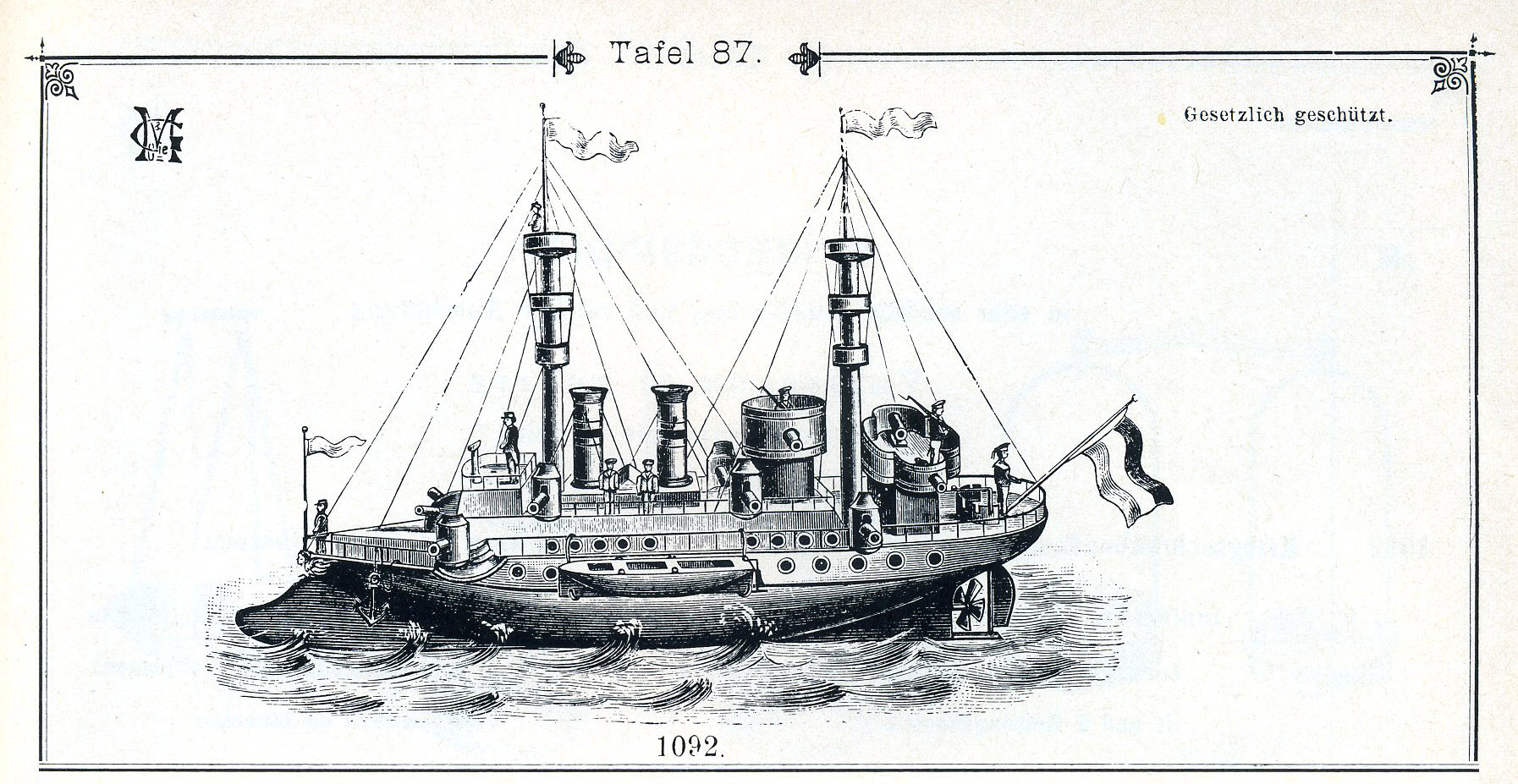
Though we could not find the exact prototype this model was based on, we did find a ship from the same era that closely resembles some of the features seen on this ship. The SMS Hertha was a cruiser of the Victoria Louise class, built for Kaiserliche Marine, or German Imperial Navy, in the 1890s. The SMS Hertha was launched by the AG Vulcan shipyard in April 1897, and later commissioned into the Kaiserliche Marine in July 1898. The ship was primarily used for coastal defense. With a top speed of 19 knots and a battery of two 21 cm guns and eight 15 cm guns, the vessel was both quick in the water and carried enough firepower to defend German coastlines.
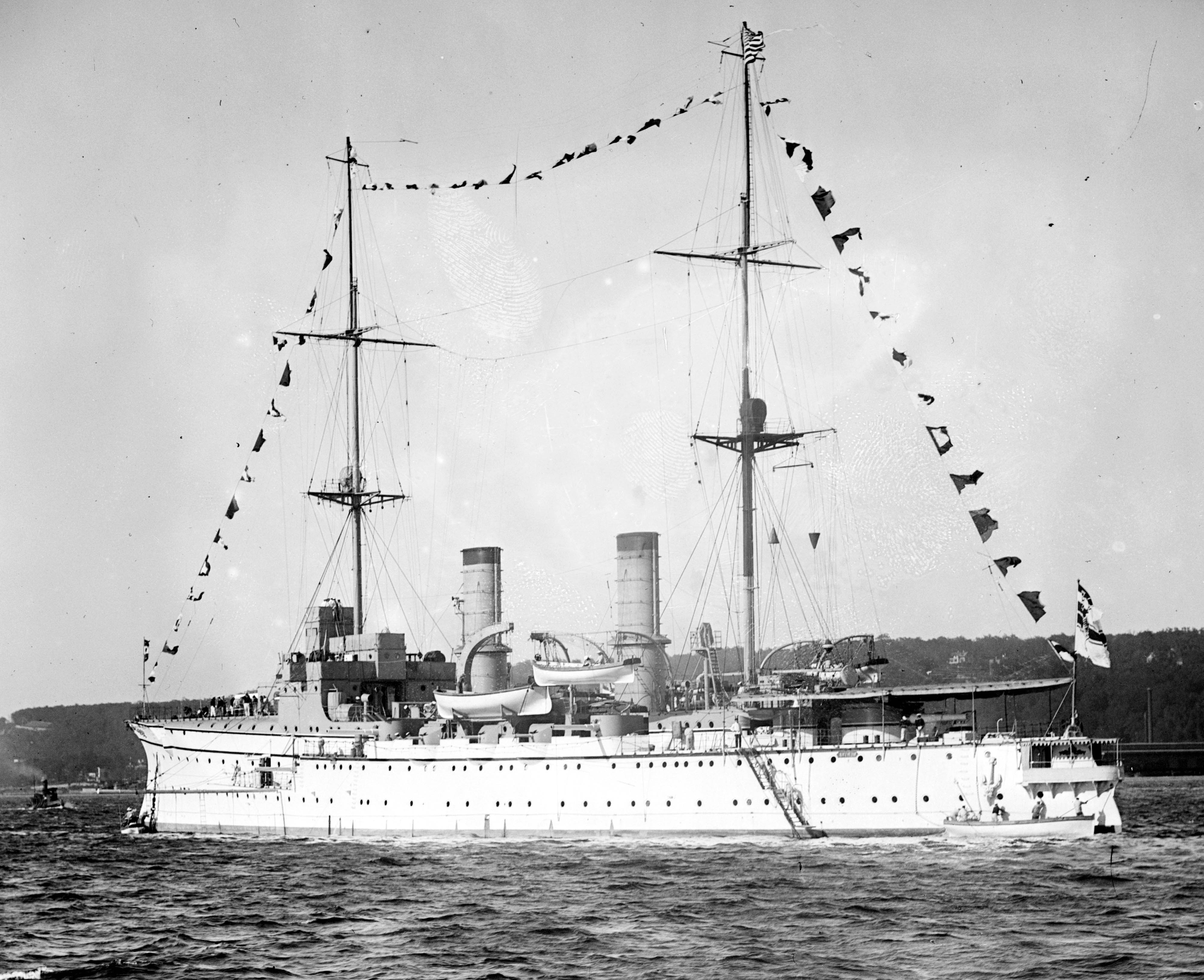
The 1895 catalog featured approximately 10 different war ships, the longest of which was 105cm. The war ships were slightly outnumbered by other non-military ships including wheel-steamers, salon ships, and yachts. No submarines could be found in the catalog yet, likely because they were not yet used in wartime. Submarines were certainly around during the time. The Brandtaucher, arguably the first German submarine, sank to the bottom of Kiel harbor on 1 February 1851 during a test dive lead by its 3-man crew.
By the next major catalog in 1905, several advancements came to the range of Marklin war ships. First, the range of Torpedo Boats was introduced – for both clockwork and steam propulsion. Most models were fitted with a slide valve cylinder, a steam whistle, safety valve, a torpedo tube, search light, and air-pressure-steering system which the catalog states is fitted for every boat.
The air-pressure steering was certainly an innovation for Marklin. The steering system came with a hand pump and a connecting rubber hose. Additional hoses and union fittings could extend the hose up to 20 meters to allow for remote steering of the boats. The catalog states that this system allows for not only better imitation of the real boats, but also convenience in that the boats no longer get lost in the water because they can be remotely steered back to shore. Surely setting a steam boat off in a straight line across a large lake could be disastrous without this steering system!
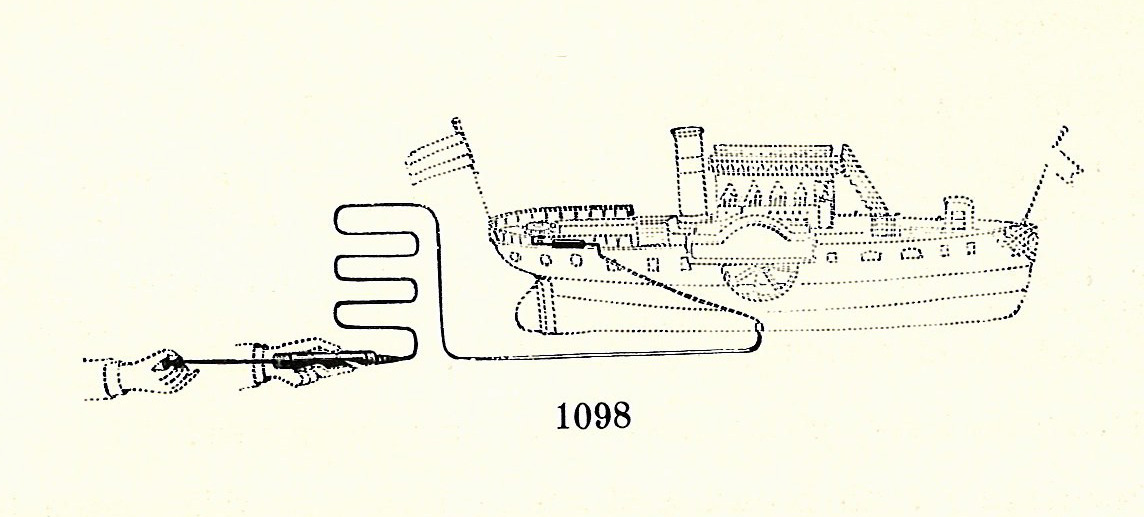
Germany was the first country to employ submarines in war for the purpose of disrupting shipping supply lines and merchant ships. Its strategy was highly effective during WW1 and WW2.
Wittelsbach-Klasse Large Dreadnought Battleships
Starting with the 1907 additional catalog we can see a very large pre-dreadnought battleship appear in the product offering. Additionally electric operation came onto the market via dry-cell battery operation. These electric operation boats (which also include electric lighting) are very sought after today and fetch much higher prices than their steam and clockwork counterparts. The largest of these dreadnoughts is 117cm long.
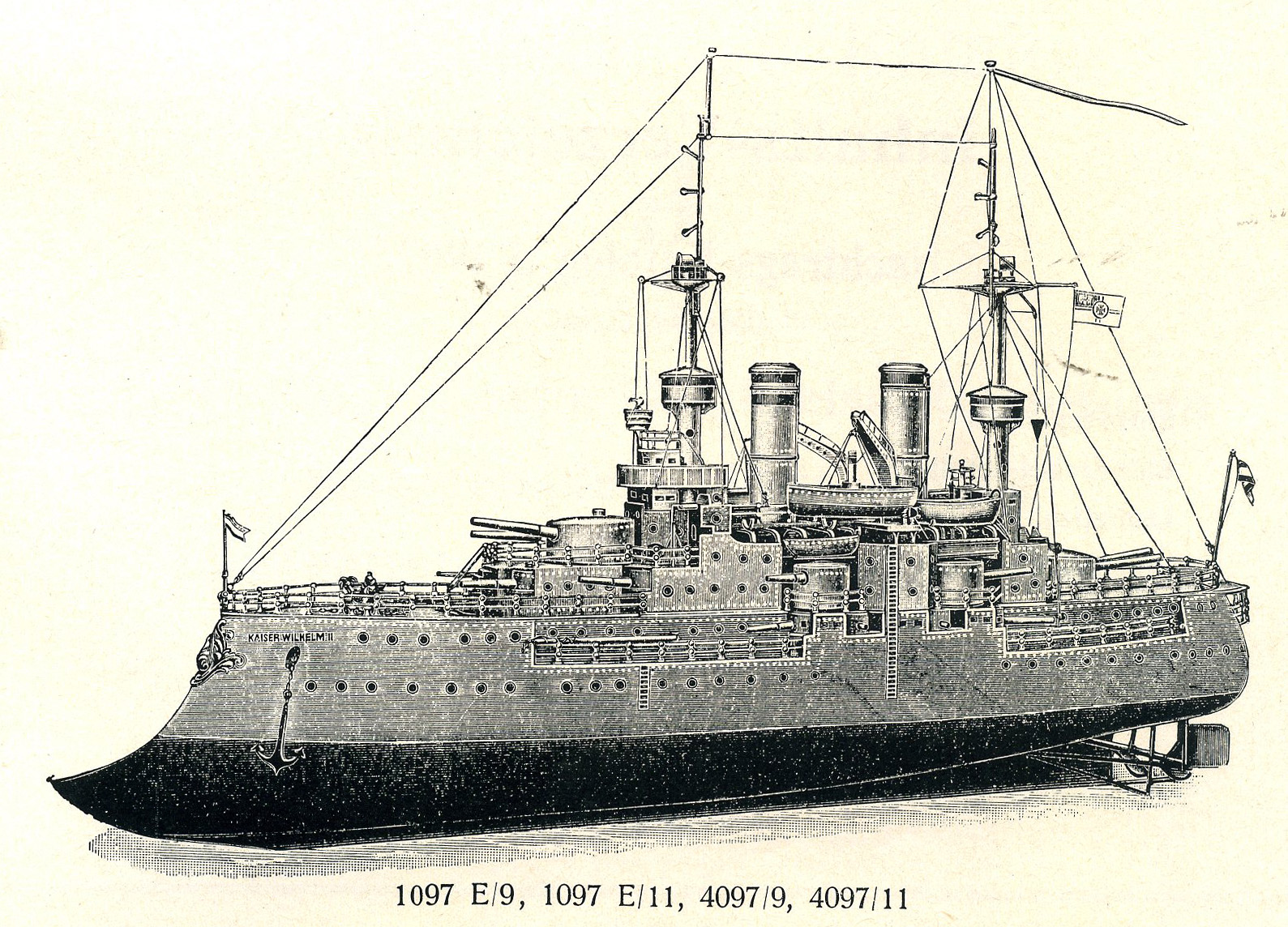
The clockwork version of the largest ship has a reported runtime of 1.25 hrs while the electric version boats a total runtime of around 6 hours – and that includes the two headlights burning during operation!
U-Boat Submarines Glide onto the Market
It’s not until after WW1 that we see the classic fully submersible submarine enter into the product range. Prior submarine-style boats were actually torpedo boats and only partially submerged.
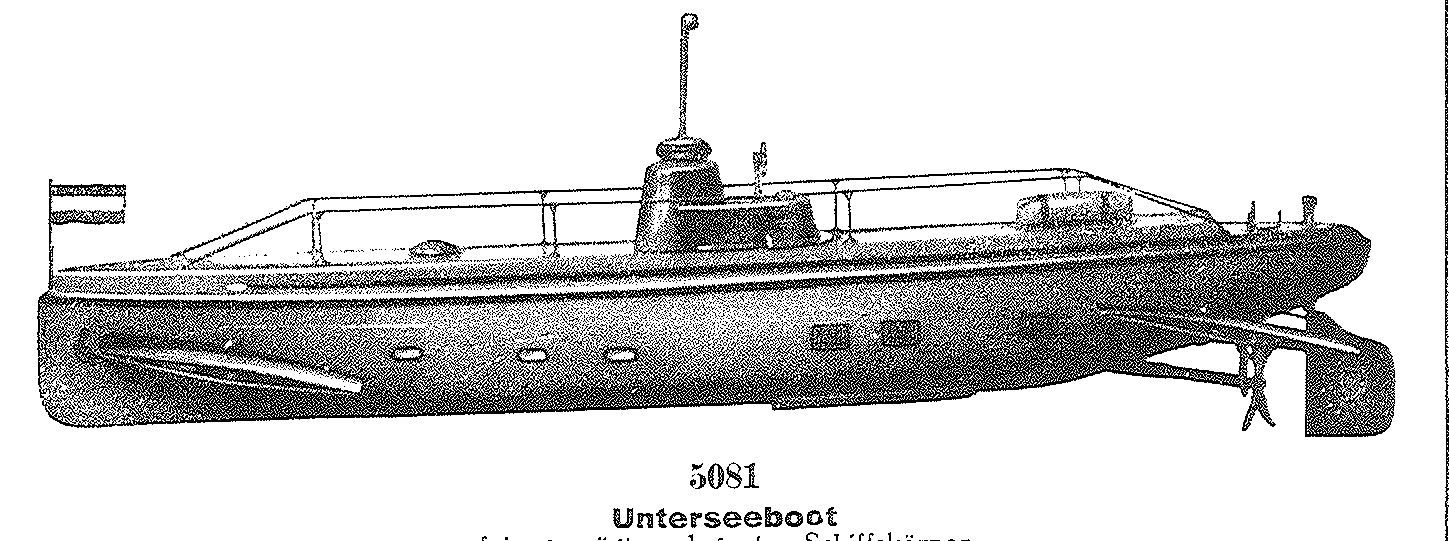
Related to submarines – the U Boat 139 sank the Lusitania, a British liner, on May 7, 1915 off the southern coast of Ireland. About 1,150 men, women and children, perished – 114 of which were Americans.
Somewhat ironically Marklin also produced a variation of a passenger ship with the ship name Lusitania. Ships of all kinds could be requested with special names – we’ve seen boats in America with ship names like America, New Jersey, Boston, etc. and so a special-order name is not out of the ordinary. However, the name Lusitania carries extra significance because of its history and the fact that it was made by a German firm like Marklin, whose motherland was responsible for sinking the British ship. One can wonder who ordered the ship – was it a German naval officer who wanted the ship as a war prize? or a British or American family wishing to remember this tragic memory? Unfortunately the provenance of the piece is unknown – other than that it was sold twice by Sotheby’s over the past few decades. The possibility that the ship name was added later is certainly not out of the question and could have been performed by a highly skilled restoration artist.

Sadly as the 1920s came to a close so did Marklin’s production of boats, submarines and ships of all kinds. As Marklin’s offering catered toward a more broad base of toy enthusiasts and not just the rich or royalty, their product offering needed to become more accessible in terms of both space and budget. The introduction of 00 scale in 1935 also shifted focus back heavily on toys. The production of boats ended much sooner than the large gauges trains did, which were last produced in 1954 with O Gauge trains.


The Lusitania has been discovered with arms, munitions in it’s cargo hold. Against the idea it was just a passenger ship. USA leadership was wanted war, used the sinking to further that aim.
Thank you, Matthew, for the extra info!
Paul,
Thanks very much for this very interesting article. The warships of the Kriegs Marine and Royal Navy were undergoing rapid change in the late 19th – early 20th century making it a fascinating era. The use of the term “schrauben” would refer to propulsion by screws or propellers, as opposed to side or stern wheels. The class “Victoria Louise” would be named after Queen Victoria’s daughters, one of which married the Kaiser, Wilhelm’s father.
Regards,
Mike
Hi Mike,
Thanks very the extra detail around the “schrauben” – I’ll update the article.
Paul
Thank you, I enjoyed the article and the information on naming options for the liners.
I am just discovering this site. I am finding it very interesting. Does anyone know where I can find a cross section view of the Marklin Untersee Boot. I am looking for clues about how the internal mechanism works.